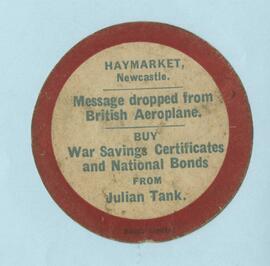Papers of Louis Edward Wilson, 1914-1959, relating to World War One Fundraising Tank Campaign and to the waterproofing of tanks during World War Two, including: booklet, The German Raid on the Hartlepools, December 16th 1914 , with photographs of bomb damage and list of the dead, 1914; correspondence, photographs, brochures, programmes, invitations and publicity material relating to the National Tour around the UK of the Tank Campaign of the National War Savings Committee, 8 Jan 1917-19 Dec 1919; letters from Maj Gen Sir Ernest Swinton, contributor to the invention of the tank and first commander of the Tank Corps, 18 Aug 1922-18 Jul 1945; correspondence concerning Wilson's career and the process of tank waterproofing, 14 Sept 1939-28 Jun 1946 and 3 Jan 1959; papers relating to tank waterproofing, 1940-1945, including: notes on supplies for the Dieppe raid, Aug 1942; notes taken from minutes of Tank Committee meetings, Aug 1942-Jun 1943; lists of companies manufacturing tanks, 1945; summary of the uses of Bostik in tank wading, Aug 1940-Jan 1945; 'A Tank Goes for a Swim', illustrated article from Picture Post , 21 Oct 1944; German aerial photograph of Coventry, showing Armstrong Siddeley aircraft engine works, Oct 1940; photographs of tank landings on manoeuvres in the UK, 1943, in Sicily and Italy, 1943, and in Normandy, 1944; booklets containing waterproofing and wading instructions, 1943-1944, for tanks including the Churchill Mk I, II, III, and IV; Light Tank M5, M5A1 and Howitzer motor carriage with radio equipment; Sherman Mk III and Mk V; Stuart Mk III and Mk V; Car, Scout and Humber Mk I and II; Armoured Car and Humber Mk I, II, III and IV; Valentine Bridgelayer; Armoured Car, Staghound; Churchill AVRE; Churchill ARV; Centaur Mk IV; 3in gun motor carriage M10; Carriers; Crusader, Gun Tractor Mk I; Cromwell Mk I, II, IV, V, VI and Centaur Mk I, III, IV. Also copy of We Planned the Second Front by Maj John Dalgleish (Gollancz, 1945) with mention of the waterproofing efforts.


